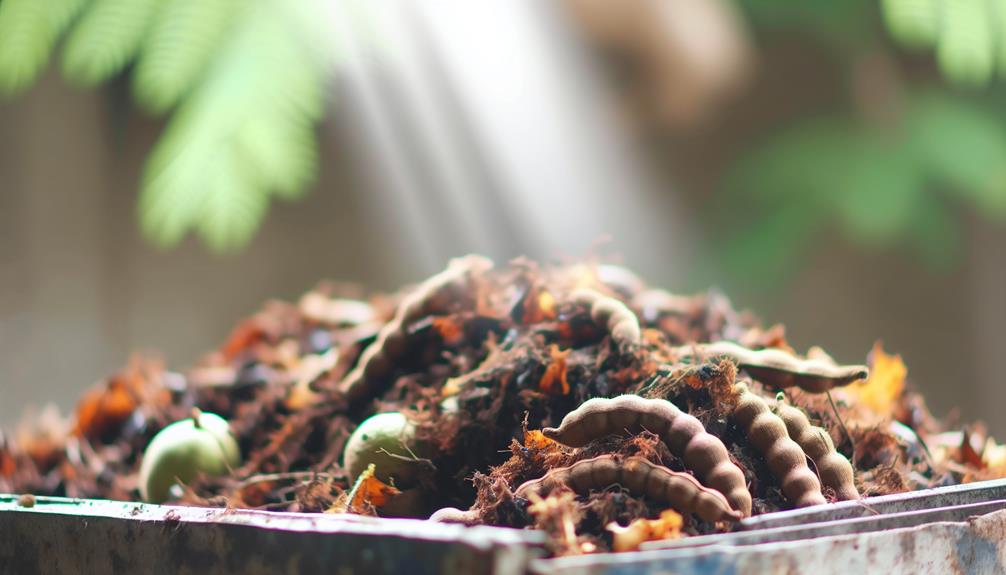

Yes, you can compost tamarind. Its peels, seed pods, seeds, and pulp enrich your compost pile with essential nutrients. To speed up decomposition, break down these parts into smaller pieces. The peels and seed pods provide carbon and nitrogen, while the pulp decomposes quickly, enriching the soil.
Crush the seeds to accelerate their breakdown. Combine tamarind waste with other green materials and balance with brown materials for effective composting. Guarantee proper aeration and moisture to prevent pests and odors. Keep turning your compost for best results. If you manage it well, the benefits are substantial for your garden.
Composting tamarind offers numerous benefits, including enriching the soil with essential nutrients. By composting tamarind, you’re not just discarding waste; you’re transforming it into a valuable resource for your garden. Tamarind is rich in organic matter, which, when decomposed, contributes greatly to soil enrichment. This organic matter improves soil structure, water retention, and aeration, creating an ideal environment for plant roots to thrive.
Moreover, composting tamarind aids in waste reduction. Instead of sending tamarind peels and seeds to the landfill, you can turn them into compost that nourishes your garden. This process reduces the volume of waste and lowers your environmental footprint. It’s a practical way to contribute to a more sustainable lifestyle, aligning with a community of like-minded individuals who care about the environment.
To get started, gather your tamarind waste and mix it with other compostable materials like vegetable scraps, leaves, and grass clippings. Maintain a good balance of green and brown materials to keep a healthy compost pile. With regular turning and proper moisture levels, you’ll soon have rich compost ready to enhance your garden’s soil.
Also Read: Can You Compost Basil?
When dealing with tamarind waste, you’ll primarily encounter peels, seeds, and pulp residue. Each of these components plays a role in your composting efforts.
Tamarind shells, also known as peels, are the outer layer that you remove when preparing the fruit. These shells are quite fibrous and can break down over time, adding valuable carbon to your compost pile.
Next, you’ll find the seed pods, which encase the tamarind seeds. These pods are sturdy and may take a bit longer to decompose. However, they offer a great source of nitrogen, balancing out the carbon-rich materials in your compost. The seeds themselves are hard and dense, often requiring more time to break down.
Finally, there’s the pulp residue. This is the sticky, fibrous part that clings to the seeds. The pulp is rich in nutrients and decomposes more quickly than the shells or seed pods. By adding tamarind pulp to your compost, you’re contributing essential minerals and organic matter that help create rich, fertile soil.
Understanding these different types of tamarind waste will help you manage your compost more effectively, ensuring that each component breaks down efficiently and enriches your soil.
Also Read: Can You Compost Barbecue Sauce?
Prior to composting tamarind waste, it is important to break down the peels, seeds, and pulp into smaller pieces to accelerate decomposition. Start by separating the tamarind shells from the pulp.

Use a knife to cut the shells and pulp into manageable pieces. For the seeds, consider using a mortar and pestle to break them down, as they can be quite tough. Smaller pieces decompose faster, making the composting process more efficient.
Here’s a quick guide to help you prepare tamarind for your compost bins:
| Step | Action |
|---|---|
| 1. Separate Shells | Remove the tamarind shells from the pulp. |
| 2. Cut Pulp | Slice the tamarind pulp into smaller pieces. |
| 3. Break Seeds | Crush the seeds using a mortar and pestle. |
| 4. Add to Bin | Place the prepared tamarind in your compost bins. |
Regularly adding tamarind waste to your compost pile guarantees a balanced mix of green and brown materials, which promotes efficient decomposition. Tamarind, rich in nitrogen, counts as a green material and provides essential tamarind nutrients to your compost.
To make sure your compost pile thrives, mix tamarind peels and seeds with other green materials like vegetable scraps and coffee grounds. This combination helps break down the organic matter more efficiently.
When adding tamarind, consider the decomposition time. Tamarind seeds, being tough, take longer to break down. Crushing or grinding them beforehand can speed up the process.
Mix the tamarind waste well with brown materials like dried leaves, straw, and cardboard. This balance ensures proper aeration and moisture levels, important for microbial activity.
Keep your compost pile moist but not waterlogged. Regular turning of the pile helps maintain an even decomposition rate. By incorporating tamarind waste, you’re enriching your compost with valuable nutrients, fostering a sense of shared purpose with nature’s recycling.
Also Read: Can You Compost Artichoke?
Even with the best practices, composting tamarind can sometimes present challenges that need addressing. One common issue is the attraction of pests. To minimize common pests like rodents and insects, always bury tamarind deeply within the compost pile.

Consider covering the compost with a layer of soil or using a compost bin with a vital lid. This prevents pests from accessing and disrupting your compost.
Odor issues are another obstacle you might face. If your compost pile starts to emit a foul smell, it’s often due to an important balance between green (nitrogen-rich) and brown (carbon-rich) materials.
Make sure you’re mixing tamarind with plenty of dry leaves, straw, or shredded paper. This balance helps maintain proper aeration and prevents anaerobic conditions, which are the main culprits behind odor problems.
Lastly, turning your compost regularly is essential. This not only helps with aeration but also evenly distributes moisture and decomposing materials, reducing both pest attraction and odor issues.
Yes, you can compost tamarind pulp and its seeds. Doing so boosts your compost’s nutrient content and adds composting benefits. Including these materials helps you create richer, more fertile soil, enhancing your gardening community’s success.
You’re curious about the decomposition time for tamarind in compost. It usually takes several months, but moisture levels play an important role. Keep your compost moist, and you’ll speed up the process, feeling like part of nature’s cycle.
When composting tamarind, you might attract pests like fruit flies and rodents. Effective pest control involves covering the compost with brown materials and turning it regularly. Your community garden will thank you for maintaining a pest-free compost pile!
Yes, tamarind fruit can attract animals to your compost pile. To prevent this, use a compost cover. This helps you maintain the community spirit by keeping your compost area tidy and animal-free.
When you compost tamarind, it can slightly affect the pH balance, potentially increasing soil acidity. However, combining it with other compost materials guarantees a healthy mix. You’re contributing to a thriving, balanced compost community.
Composting tamarind is straightforward and beneficial for your garden. Make sure you properly prepare the tamarind waste by breaking it down into smaller pieces.
Add it to your compost pile, balancing it with other green and brown materials. Regularly turn the pile to maintain aeration and monitor moisture levels.
If you encounter issues like slow decomposition or odor, adjust the balance of materials. By following these steps, you’ll efficiently turn tamarind waste into valuable compost.
